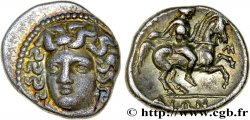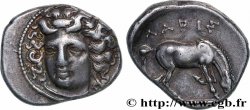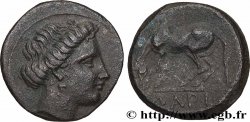v24_0073 - TESALIA - LARISA Drachme
MONNAIES 24 (2005)
Precio de inicio : 145.00 €
Valoración : 300.00 €
lote sin vender
Precio de inicio : 145.00 €
Valoración : 300.00 €
lote sin vender
Tipo : Drachme
Fecha: c. 350 AC.
Nombre del taller / ciudad: Larissa
Metal: plata
Diámetro: 18 mm
Eje de acuñación: 12 h.
Peso: 5,4 g.
Grado de rareza: R2
Comentarios sobre el estado de conservación:
Flan ovale avec un très beau portrait de Larissa au droit. Revers piqué et corrodé, légèrement décentré. Une patine avec des reflets dorés orne le droit
N° en los catálogos de referencia :
Anverso
Titulatura del anverso: ANÉPIGRAPHE.
Descripción del anverso: Tête de la nymphe Larissa de face tournée de trois-quarts de face à gauche, les cheveux retenus par un bandeau (l'ampyx).
Reverso
Titulatura del reverso: LÉGENDE PARTIELLEMENT INVERSÉE.
Descripción del reverso: Cheval à gauche, levant l'antérieur gauche, s’ébrouant.
Leyenda del reverso: [LARISAIWN]
Comentario
Poids léger. Cet exemplaire sur un flan étroit tout en étant relativement complet nous montre la maîtrise artistique du graveur qui a su habilement adapter son sujet à la forme circulaire du flan, tant au niveau du droit, où la chevelure vient harmonieusement occuper l’ensemble du flan et au revers, où le cheval semble se courber. La représentation du cheval à gauche est beaucoup moins courante.
Lightweight. This example on a narrow flan while being relatively complete shows us the artistic mastery of the engraver who knew how to skillfully adapt his subject to the circular shape of the flan, both on the obverse, where the hair harmoniously occupies the entire flan and on the reverse, where the horse seems to bend. The representation of the horse on the left is much less common
Lightweight. This example on a narrow flan while being relatively complete shows us the artistic mastery of the engraver who knew how to skillfully adapt his subject to the circular shape of the flan, both on the obverse, where the hair harmoniously occupies the entire flan and on the reverse, where the horse seems to bend. The representation of the horse on the left is much less common








 Informar de un error
Informar de un error Imprimir la página
Imprimir la página Comparte mi selección
Comparte mi selección Haz una pregunta
Haz una pregunta Consignar / vender
Consignar / vender
 Descriptivo
Descriptivo









